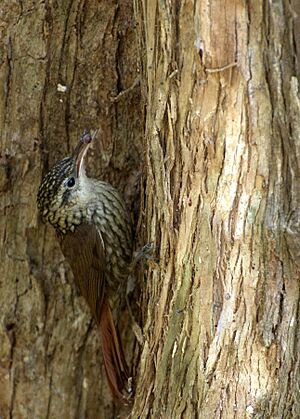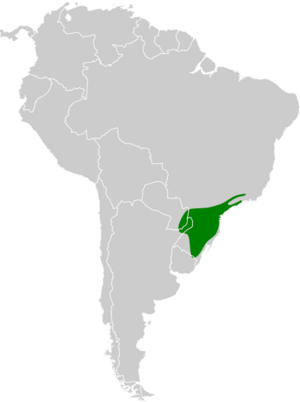Scalloped woodcreeper facts for kids
Quick facts for kids Scalloped woodcreeper |
|
|---|---|
 |
|
| Conservation status | |
| Scientific classification | |
| Genus: |
Lepidocolaptes
|
| Species: |
falcinellus
|
 |
|
The scalloped woodcreeper (Lepidocolaptes falcinellus) is a type of bird that lives in forests. It belongs to a bird family called Furnariidae, which includes ovenbirds. You can find this bird in countries like Argentina, Brazil, Paraguay, and Uruguay.
Contents
About the Scalloped Woodcreeper
The scalloped woodcreeper is a unique bird. It is closely related to another bird called the scaled woodcreeper. Scientists used to think they were the same species, but now they know they are different, though still like "sister species." This bird is the only type in its group, meaning it does not have different subspecies.
What Does the Scalloped Woodcreeper Look Like?
This medium-sized woodcreeper is about 17 to 20 centimeters (7 to 8 inches) long. It weighs around 26 to 30 grams (about 1 ounce). Both male and female birds look the same.
Its face is a creamy white color with some dark spots. It has creamy white areas around its eyes. The top of its head and the back of its neck are dark. They have clear, light buff spots that can look like faint stripes on its upper back.
The bird's back and wing feathers are olive-brown to cinnamon-brown. Its lower back and tail feathers are a reddish-brown color. The main flight feathers have brown outer parts and reddish-brown inner parts. Their tips are dark brown.
Its throat is whitish. The feathers on its belly are olive-colored with bold, buff-colored stripes that have dark edges. These stripes make it look like it has scales. The feathers under its wings are cinnamon-colored. Its eyes are brown. Its legs and feet are greenish-gray to greenish-brown. The top part of its beak is gray, light brown, or pinkish. The bottom part of its beak is creamy white to light brown.
Where Do Scalloped Woodcreepers Live?
You can find the scalloped woodcreeper in southern Brazil, southeastern Paraguay, northeastern Argentina, and a tiny part of northeastern Uruguay.
It lives in humid forests, especially the Atlantic Forest. It also lives in drier forests in the Brazilian Highlands. In the northern parts of its home, it prefers mountain evergreen forests and rainforests. Further south, it lives in forests with Araucaria trees. Sometimes, it can be found in forests that lose some of their leaves.
This bird lives both at the edges and deep inside old, untouched forests. It also lives in older forests that have grown back after being cut down. It usually lives from lowlands up to about 1,600 meters (5,200 feet) high. Very rarely, it can be found as high as 2,000 meters (6,600 feet).
How Scalloped Woodcreepers Behave
Movement
Scientists believe that the scalloped woodcreeper stays in the same area all year round. It does not migrate to different places.
Feeding Habits
We do not know everything about what the scalloped woodcreeper eats. However, it seems to mostly eat small creatures like insects and spiders. It usually looks for food alone or with one other bird. Often, it joins groups of different bird species that are feeding together.
The bird moves up tree trunks and along branches. It mostly searches for food in the middle and top parts of the forest. Sometimes, it looks for food closer to the ground. It finds most of its food on plants that grow on trees, like epiphytes, bromeliads, moss, and in the cracks of tree bark. It has also been seen flying out to catch insects in the air.
Reproduction and Life Cycle
The breeding season for the scalloped woodcreeper is not fully known. It seems to happen from at least October to December. These birds build their nests inside holes in trees. They line their nests with pieces of bark.
One nest was found with two eggs. The eggs hatch after 15 to 16 days. The young birds leave the nest 18 to 19 days after they hatch. Both the mother and father bird take care of the eggs and feed the baby birds.
Sounds and Calls
The song of the scalloped woodcreeper has not been described in words. Its call is a somewhat slurred rattling sound. People have described it as "pit, eu-u-u," "pee-u-u-u," or "peekku."
Status and Conservation
The IUCN (International Union for Conservation of Nature) has said that the scalloped woodcreeper is a species of "Least Concern." This means it is not currently in danger of disappearing. It lives in a fairly large area. Even though we do not know exactly how many of these birds there are, their population seems to be stable.
No immediate threats to the scalloped woodcreeper have been found. It is considered quite common in the main parts of its range. It is less common at the edges of the areas where it lives.
Even though it is thought to be sensitive to human activity, it can still live in good numbers in older forests that have grown back. It can even live in relatively small forest areas in southern Brazil. The scalloped woodcreeper lives in several protected areas, which helps keep it safe.


